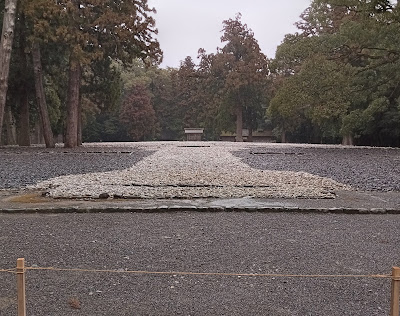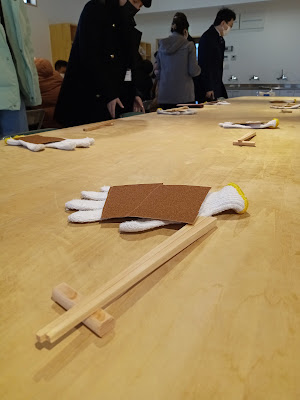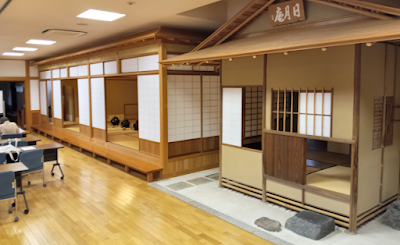Day-4, more about Ise the city of today, Yamada & Geku
 |
| adjacent to the worship ground for the kami, Tomouke |
There Pr. S. guided us through some of the highlights at the Sengu-kan, an exhibit hall made from the renewal work last completed in the 2013 cycle of 20-year, generational building of shrines to replace the old ones. The light rain persisted, so our group moved as one while jostling our umbrellas as little as possible when bowing at the torii that marks the sacred space. We learned that food is prepared and offered (and tidied away and distributed among staff) to the kami every morning and evening in one of the adjacent buildings of the shrine ground. This photo shows the ground that lies immediately east of the current installation of the shrine. In October 2033 the roles will reverse so that this location will support the buildings, fences, and walls and the other one to the left (west) of this photo will be the empty one.
From the Geku we walked a short distance to the Ise Washi factory that makes Japanese paper for sale all around the country and in some foreign locations, too. It has been going since 1899 when three businesses merged into one. The whole process for handmade paper to order can take a week or more to go from bark of the mitsumata 'paper bush' to finished washi, depending on the purpose and degree of desired fineness or rusticness.
Many of the seminar participants eagerly bought some of the washi offered for sale. With the rain tapering off, the group turned toward the hotel at the end of the afternoon, filled with history and also with a new respect for the making of paper and all its uses to scholars, as well as for the ritual needs of the Ise Jingu administration, trainees, researchers, and all functionaries. As a bonus, our host at the factory invited us to a photo exhibition of Mr. Miwa that is attached to the factory grounds in which impressionistic renderings of flowers were printed onto the soft glow and delicate surface of washi: entitled "Ka Ren 2," (February 26 - March 26).
In summary for Day-4, the tremendous expertise being shared with seminar participants is something local residents, and perhaps also the Kogakkan University students do not learn in this way. A person in Ise might learn little by little, but not all at once with a chance for Q and A, too. And so the institutions of Shinto have been central to the making of Ise and its current configuration, too, although Ise's people and community life is much wider than Shinto-only. The washi maker illustrates this well: yes, they supply the Ise Jingu with a range of custom papers suited to many uses, but their business also meets the needs of everyone else, too, not just in the city but nationwide and sometimes even to more distant customers. So the study program goes beyond its title of Ise and Japan. It digs deeply into the Ise Jingu past and present (and future, by extension), which has played a part in the making of Ise and its present-day life, which also has figured into the course of events around Japan and from there as part of Japan's presence in the wider planet of nations and businesses, too.




Comments
Post a Comment